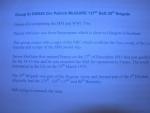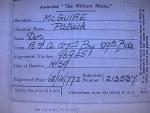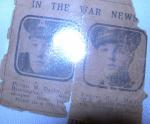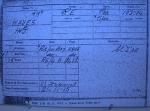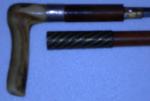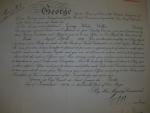-
Posts
13,225 -
Joined
-
Last visited
-
Days Won
22
Content Type
Profiles
Forums
Blogs
Gallery
Events
Store
Everything posted by Mervyn Mitton
-

19th.C. TRANTER REVOLVER - HELP?
Mervyn Mitton replied to Mervyn Mitton's topic in Firearms & Ordnance
-

19th.C. TRANTER REVOLVER - HELP?
Mervyn Mitton replied to Mervyn Mitton's topic in Firearms & Ordnance
-

19th.C. TRANTER REVOLVER - HELP?
Mervyn Mitton replied to Mervyn Mitton's topic in Firearms & Ordnance
-

19th.C. TRANTER REVOLVER - HELP?
Mervyn Mitton replied to Mervyn Mitton's topic in Firearms & Ordnance
-
I am hoping that some of the experts in this sub-forum, will be able to identify which model of Tranter this is, and also a date? I only bought it this morning so, it has yet to be cleaned. I think most of the bluing is under the grime and there is some fine decorative engraving. Unusually, there is an owner's name engraved along the top - JOHN HAYTON GRAHAM'S TOWN - strangely, the word Graham's Town is shown with an apostrophe and as separate words. Grahamstown is the capital of the eastern Cape and was formed by the 1820 settlers - in (wait for it !) 1820. I spoke to the museum this morning and his name isn't familiar - however, this was the centre for the 7th, 8th, and 9th. Kaffrarian Wars. I found some info. on the web - but it doesn't help date it to a model or, year. Will show a number of photos and will be most grateful for any help.
-
Helen - there are some rare and valuable ones here. Will start with the one top left. The small end grip is either ivory or, bone. The fittings look to be brass. I would like to see a close-up of the sheath - you say plaster covering, however, I think it is more probable to be either a fish skin (ray?) or, a tree bark. Whatever the covering , it's purpose is to stop an enemy grabbing to pull out of your grip. The second one is very similar to my own ( see under swords) and will date to the early part of the 19th. C. The grip ia Scottish staghorn and the joint part has been carved as a shell. The purose of the cord is to wrap it around your wrist - and again, stop someone pulling it from you. The Namibian one is a typical style for most of Southern Africa - and it is, of course, a dagger stick. To make the long aperture for a sword blade is difficult and requires special machinery. The shaped head is based on a knobkerry - or, fighting stick. The Pakistani one is probably 20th.C. and is a very neat design - the curved grip was either to sit on - like a 'shooting stick' or, was intended to brace on the arm or shoulder. Very neat how the ferrule takes out to make a small dagger for the left hand. Any more ?
-
Leigh - have never heard of as modern truncheon with a firearm built-in. There is one in my book , with a brass eagle grip - now worth about ?5000, but,it's early Victorian. Have you a photo or, ref. ? Helen, will look for your swordsticks post. Mervyn
-
I have a feeling that many on this forum have a greater interest in later planes ? However, this is an interesting picture from 'With the Flag to Pretoria' - publ. in 1900. The balloons were tethered and proved useful for observation on the flat plains of Sth. Africa, during the Boer War (1899-1900). The Royal Naval Air Service had their first dirigible in 1907 - she was named Nulli Secundus (second to none)
-
Stuart - what a cracking helmet and plate ! You should have put it sep. - it may not get noticed. When you see how the plate stands out with the backing, you can understand why so many badges have open spaces. The plate are available - all of my things are. Will IM. (says he proudly - I've just discovered how to send them !!!)
-

BRITISH MM GROUPS
Mervyn Mitton replied to Mervyn Mitton's topic in Great Britain: Orders, Gallantry, Campaign Medals
-

BRITISH MM GROUPS
Mervyn Mitton replied to Mervyn Mitton's topic in Great Britain: Orders, Gallantry, Campaign Medals
-

BRITISH MM GROUPS
Mervyn Mitton replied to Mervyn Mitton's topic in Great Britain: Orders, Gallantry, Campaign Medals
-

BRITISH MM GROUPS
Mervyn Mitton replied to Mervyn Mitton's topic in Great Britain: Orders, Gallantry, Campaign Medals
-

BRITISH MM GROUPS
Mervyn Mitton replied to Mervyn Mitton's topic in Great Britain: Orders, Gallantry, Campaign Medals
Leigh thought I should post oa few of the details. The first three relate to Hayes and the other two are for Mcguire -
Helen, the spike would allow it to be swung around for reloading - so land or sea is a possibility. I may have missed a point, but why do you keep saying 1916 ? The percussion cap action would date it between ( for middle east uses anyway) approx.1820-1870.
-
Swords sticks are very collectible and it would be interesting to see the ones in the collection. The gun sticks usually fire a .22 cartridge. They used to be popular in Sth. Africa, where we have many snakes and rabies is common - however, they now require a firearms license. For the moment - swords sticks are not illegal - the offence is to use one. In the UK it is illegal to carry, sell ,or, make one. OK in a collection, but not to taken outside. With Leigh's explanation on colours , I hope we have been able to help a little. I can remember arresting a min-cab driver, who had a very pistol under his seat. It is an 'absolute' offence - but, I don't think he got into much trouble as there was no cartridge.
-
All things are possible , but I would feel a rampart gun is more likely the origin. Also, keep in mind that the Turks are a seafaring nation and this type of large bore gun - with a spike - was often used on board early ships to repel boarders. They could fire one solid shot - or, an amount of small shot , which would be useful against numbers of people. Had it been English, it would have been a valuable item - check with the Tower Armouries at Leeds. With location - that part of the World is a 'melting pot' and weapons tend to move around. How big is the bore?
-
Google - Very Pistol - if you haven't already found your answers, this site should give the info.. The German one might look different , but all are variations on a 'theme'. They are Part 1 firearms in the UK and require a license. A museum may have exemption , but, I think you should establish this. Best wishes
-
-
This is an interesting swordstick - carried in the Anglo-Zulu War of 1879 - by a captain in the Gordon Highlanders. They were re-inforcements and arrived in about March - they were active for the remainder of the campaign and the final defeat of the Zulus at the Battle of Ulundi. The stick is probably much earlier, being of pattern common at the beginning of the 19th.Century. The handle is Scottish staghorn and the cane itself, is Malacca. This comes from the island of Malacca in the Indonesian islands and , strangely, there are male and female types of this plant - this is male and it does not break - just splits along the wood. Most of these sword sticks use old levee swords , which are ideal in length and thickness. Levee swords are worn only in the presence of the Sovereign - or, a direct representitive - i.e. Viceroy, or, Governor General. They can be for civilians or, the Services, but in a Regt. probably only the Lt.Col. and his senior majors would have one. The rarity with this stick , is that before he returned to UK, he had a Zulu put binding on the shaft. This was woven from copper and brass wire that the Zulus exchanged ivory and hides for, from the Portuguese in Delgoa bay. The provenance that this binding gives, makes the stick extremely valuable. I always carry it when in the wheelchair - would give a 'mugger' a big shock !!
-
Hi! I don't usually 'stray' into your territory, but have a couple of items you might be interested in having a look at - just hope this one can be read. I thought the dates on this Commission were interesting - his appointment is months earlier then the Commission - which is back dated. Did they hold it back with the impending change from RFC to RAF ? Also, did he ever do anything useful - i.e. WW2 service ?
-
Hi! I don't usually 'stray' into your territory, but have a couple of items you might be interested in having a look at - just hope this one can be read. I thought the dates on this Commission were interesting - his appointment is months earlier then the Commission - which is back dated. Did they hold it back with the impending change from RFC to RAF ? Also, did he ever do anything useful - i.e. WW2 service ? PICTURE DIDN'T APPEAR - HAVE RE-POSTED BELOW
-
I think it was included when they commissioned new arms - in the early 1970's (?) - because both the old and the new Scotland Yards are in Westminster. I agree with you - the old arms were much better - do you have one to show (I would rather leave it to you - I'm sick of seeing my name - but I enjoy putting the pieces out)








